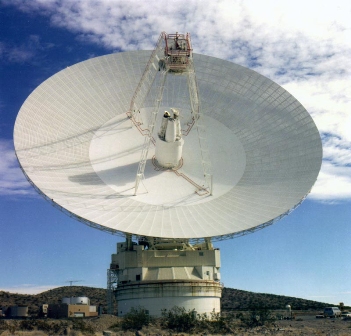

Celebrating 40 Years of Intent Listening
By Diane K. Fisher
In nature, adjacent animals on the food chain tend to evolve together. As coyotes get sneakier, rabbits get bigger ears. Hearing impaired rabbits die young. Clumsy coyotes starve. So each species pushes the other to “improve.”
The technologies pushing robotic space exploration have been like that. Improvements in the supporting communications and data processing infrastructure on the ground (the “ears” of the scientists) have allowed spacecraft to go farther, be smaller and smarter, and send increasingly faint signals back to Earth—and with a fire hose instead of a squirt gun.
Since 1960, improvements in NASA’s Deep Space Network (DSN) of radio wave antennas have made possible the improvements and advances in the robotic spacecraft they support.
“In 1964, when Mariner IV flew past Mars and took a few photographs, the limitation of the communication link meant that it took eight hours to return to Earth a single photograph from the Red Planet. By 1989, when Voyager observed Neptune, the DSN capability had increased so much that almost real-time video could be received from the much more distant Planet, Neptune,” writes William H. Pickering, Director of JPL from 1954 to 1976, in his Foreword to the book, Uplink-Downlink: A History of the Deep Space Network, 1957-1997, by Douglas J. Mudgway.
Mudgway, an engineer from Australia, was involved in the planning and construction of the first 64-m DSN antenna, which began operating in the Mojave Desert in Goldstone, California, in 1966. This antenna, dubbed “Mars,” was so successful from the start, that identical 64-m antennas were constructed at the other two DSN complexes in Canberra, Australia, and Madrid, Spain.
As Mudgway noted in remarks made during the recent observance of the Mars antenna’s 40 years of service, “In no time at all, the flight projects were competing with radio astronomy, radio science, radar astronomy, SETI [Search for Extra-terrestrial Intelligence], geodynamics, and VLBI [Very Long Baseline Interferometry] for time on the antenna . . . It was like a scientific gold rush.”
In 1986 began an ambitious upgrade program to improve the antenna’s performance even further. Engineering studies had shown that if the antenna’s diameter were increased to 70 m and other improvements were made, the antenna’s performance could be improved by a factor of 1.6. Thus it was that all three 64-m DSN antennas around the world became 70-m antennas. Improvements have continued throughout the years.
“This antenna has played a key role in almost every United States planetary mission since 1966 and quite a few international space missions as well. Together with its twins in Spain and Australia, it has been a key element in asserting America’s pre-eminence in the scientific exploration of the solar system,” remarks Mudgway.
Find out more about the DSN and the history of the Mars antenna at http://deepspace.jpl.nasa.gov/dsn/features/40years.html. Kids (and grownups) can learn how pictures are sent through space at http://spaceplace.nasa.gov/en/kids/phonedrmarc/2003_august.shtml .
For over 40 years, the “Mars” 70-m Deep Space Network antenna at Goldstone, California, has vigilantly listened for tiny signals from spacecraft that are billions of miles away
This article was provided by the Jet Propulsion Laboratory, California Institute of Technology, under a contract with the National Aeronautics and Space Administration.
All content is the responsibility of LUNAR.
If you have comments or suggestions regarding these web pages,
please contact the 
Copyright © 1992 - 2025 LUNAR